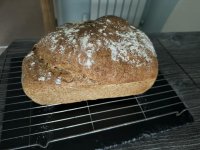ancient_mariner
Moderator
- Messages
- 24,813
- Name
- Toni
- Edit My Images
- No
I've been making granary type breads using commercial flours for some months now, but the bread is always fairly dense with a texture that's closer to cake than the more open cellular structure of a supermarket bread. I've used a variety of recipes including those from a bread machine (several recipes, and including preparing the dough in the machine, then 2nd kneeding by hand) plus hand-preparing the bread by hand all the way through. I get a decent enough rise, more than doubling dough volume for both first and second rises, and generally the risen dough is stable enough not to collapse when transferred to the oven, sometimes even visibly expanding a little further during baking.
It tastes great, but I can't seem to get a truly fluffy loaf. Are there any tricks or favourite recipes that might help?
It tastes great, but I can't seem to get a truly fluffy loaf. Are there any tricks or favourite recipes that might help?











